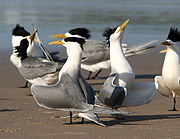
Courtship display
Encyclopedia

Great Tit
The Great Tit is a passerine bird in the tit family Paridae. It is a widespread and common species throughout Europe, the Middle East, Central and Northern Asia, and parts of North Africa in any sort of woodland. It is generally resident, and most Great Tits do not migrate except in extremely...
swells its chest to show off its black stripe, the crested tit
Crested Tit
The Crested Tit, Lophophanes cristatus , is a passerine bird in the tit family Paridae. It is a widespread and common resident breeder in coniferous forests throughout central and northern Europe and in deciduous woodland in France and the Iberian peninsula...
raises its crest, the bearded tit puffs out its black cheeks.
Male display
As well as identifying the species of the displayer and their willingness to mate, the courtship displays of male animals often include other purposes. An obvious one is to impress the female with the male's vigour and biological fitness, and to persuade her to pick him above all other males – a form of sexual selectionSexual selection
Sexual selection, a concept introduced by Charles Darwin in his 1859 book On the Origin of Species, is a significant element of his theory of natural selection...
. The display may also have the added benefit of deterring rival males.
Female display
In species where the females compete with each other to claim males for mating (e.g. polyandrousPolyandry
Polyandry refers to a form of marriage in which a woman has two or more husbands at the same time. The form of polyandry in which a woman is married to two or more brothers is known as "fraternal polyandry", and it is believed by many anthropologists to be the most frequently encountered...
species such as the phalarope
Phalarope
A phalarope or wadepiper is any of three living species of slender-necked shorebirds in the genus Phalaropus of the bird family Scolopacidae. They are close relatives of the shanks and tattlers, the Actitis and Terek Sandpipers, and also of the turnstones and calidrids...
), the females may show courtship display behaviours directed at attracting males.
Mutual display
Where male and female pair up for the breeding season, or longer, the pair-bond between the two is reinforced by doing a mutual display. Such a display often consists of synchronous actions like calling and head bobbing, or one partner repeating the motion of the other. Birds are especially well known for this type of behaviour: albatrossesAlbatross
Albatrosses, of the biological family Diomedeidae, are large seabirds allied to the procellariids, storm-petrels and diving-petrels in the order Procellariiformes . They range widely in the Southern Ocean and the North Pacific...
, penguins
Penguin
Penguins are a group of aquatic, flightless birds living almost exclusively in the southern hemisphere, especially in Antarctica. Highly adapted for life in the water, penguins have countershaded dark and white plumage, and their wings have become flippers...
and grebes
Grebe
A grebe is a member of the Podicipediformes order, a widely distributed order of freshwater diving birds, some of which visit the sea when migrating and in winter...
are three such examples.

